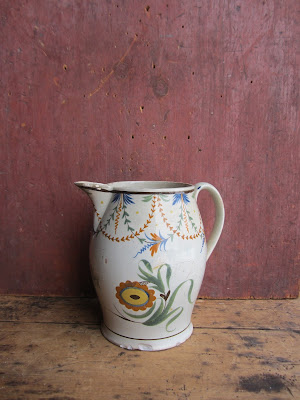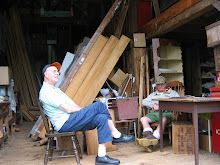Antiquarian Sophistication of the "I" and the "Eye" Upon the "It"
Part Five
"Puss in the Corner"
“Yes,
puss in the corner, but not in the way you fancy. No indeed. Puss
has been sent there to stay until she can be good.”
Is
there ever going to be a fire... that ravishes the ‘it’ all? Can you be a fire that ravishes ‘it’
all? “Burned it up.” They’ve said
to me. Quite well managed and sure
they’ve said that; “Burned it up.”
That is the commercial market for antiques
I
am speaking of.
Once
the fire is started... pile more upon it?
Celebrate, they do, the anti-knowing of “old things”. Murmurs of women. Folkways. Old stories.
Diaries never kept. Or WERE
they kept only to be burned... too... when found. Were they too... “Burned it up”.
“Go
stand in the corner... until you are GOOD.” That is what has happen to the old woman’s things. “Those there are VALUABLE; that
there. In the corner. We can’t keep her cat out of there.”
“Oh.”
I said. “I don’t want her cat.”
“You
can have her. We don’t want her
either.”
Her
old dining table chairs had been pushed against the sideboard. The top of the sideboard had been
covered with her old china that they had removed from the dining room’s two
corner cabinets. Candlestick
pairs, glassware, silver plate (?), serving service, ‘covered dishes’ and a
mirror behind. “Broken” one
heiress said.
“The
glass?” I said
“Glass?”
“The
looking glass?”
“Oh. The mirror? No. The
china. The pieces in that box”.
There
were two boxes; an old shoe box resting on top of an old shirt box. Set off to one side
On
the sideboard.
“I
don’t want to do anything today but I’ll come back when your done and buy it
all.”
“All?”
“The
whole house contents; we’ll clean it out”
“Not
just the antiques?”
“No. Everything. Of course the antiques. Just keep putting what you don’t want in the corners (of the
different rooms). You know what
your doing. Just let me know. When your done. Ready. I’ll come back.”
Puss
in the corner. They put the
antiques in the corners. It was
nine months before I heard from them again. Of course I heard ABOUT them right along. Other dealers just cannot shut-up. At least six of those... ‘had been let
in’.
“Oh.”
I’d say to them.
It
should be perfectly obvious that if the heirs know enough about the antiques in
their mother’s house... to put the antiques they don’t want in the corners of
each room... that they know nothing about antiques at all. Except but what they’ve been told. And I told them nothing. About anything. In the house.
It
was a rather large house.
Estate. Lots of rooms...
with the unwanted antiques in the corners... excepting the rather large number
of rooms where the heirs “didn’t find anything” they’d say.
“Okay. Fine.”
You
(the reader) say.
Now
your beginning to ... “see” (understand)?
Do you hear the old woman murmuring? Oh... it is still just muttering to you? One of the heirs muttered about the
coffee table... to herself. “Would
it FIT.” she... what?
I
don’t care
I
don’t want to know.
When
I came back
It
wasn’t there.
“She
has very good taste. Her house is all just like that too. Perfect”. Said Carl. To
me. Carl is her brother. He was “taking” the “tools” in the
“garage”. “JUST THE TOOLS I’M
GONNA USE.” He said. He left everything else... strewn
about... after he “DUG THROUGH IT”. “TWO TRIPS”... in his truck. The sisters didn’t “want any of that”. The grandfather’s father was a
carpenter’s assistant when he was in his teens. He helped build the church
Steeple
Down
the street... about one thousand feet... and on the same side of the
street. His tools (“old tools”)
were ‘mixed in’ and not in the ‘old tool chest’ that had been left up just
inside the garage door ...to hold sand and salt... for when ‘it’s icy’. “TOO BAD HUH. WOULD HAVE BEEN A NICE BOX ONCE”. I sold it for thirty.
Dollars. I used the sand
myself. I gave the bags of salt to
Raphael. He works at the church on
Sundays... salting the walkways when ‘it’s icy’. He’s from Brazil.
He speaks Spanish and English.
He smokes cigarettes when he stands on the walkways and surveys his
salting job.
“Want
to see if you’d LIKE any of the TOOLS?” I said to him. He came up to the garage after church
was done. That Sunday. “IF YOU CAN USE IT BETTER TAKE IT”.
“I
can?” he said.
“ONLY
WHILE I’M IN A GOOD MOOD”. We both
laughed.
He
doesn’t have a truck. “PUT IT IN
MINE and WE’LL DRIVE IT OVER”.
“That
bench? The tool bench... okay...
SURE.”
I
could have sold it. Pretty
easy. Fuck it. I did pretty well with it. By giving it to him. “It’s an antique.” I told him. He surveyed it.
“How
old?”
“World
War One”.
He
didn’t say anything more. Neither
did I. We... the two of us...
‘flipped’ it up into the truck.
It’s
been four years and he uses that bench everyday. I bet.
“Puss
in the corner” I said to the heirs.
“What
did you say?”
“Nothing”
I
think they thought I said ‘piss in the corner’. We were all standing at the front of the garage... looking
in at “the stuff”. They called it.
The
easy solution would be to re-title all the “antiques” as “stuff”; old stuff. That would get rid of ‘antiques’ and
the... that they being that are... “OLD” and “VALUABLE”. Since the ‘market’ for antiques has
been re-titled as ‘crashed’, removing the antiques title gets rid of that too;
the ‘crashed’ antiques ‘market’.
It is all, then, just ‘stuff’ in the corners of the rooms and ‘in the
garage’. Antiques become easier to
manage without the title: “Throw
the stuff out”. “Sell the stuff in
a yard sale”. It is just
‘stuff’. “Who cares?”
That
is the way it should be. One never,
then, has to consider ‘it’ by ‘eye’ of... your... ‘I’. No. Put the stuff in the garage or throw it out. Put “what I like” in the dining
room. Obviously... if there are
two small boxes of old (18th century) broken china found in the
dining room... throw that out.
That is what happens... more... and more... and more... these days. This is because “no one” “knows
anything”. That is what the actual
‘market crash’ of ‘antiques’ is:
No one knows anything. It
is all just “stuff”. And no one
“BUYS” “STUFF” unless it is a... “what I like”. That is the whole round (circle) of the market (vast
percentage of the market). It is
furthered by the ‘what I like’ being supported by a buttress (flying buttress?)
of “what sells”. “Stuff” that
“sells” is “what sells”.
An
example? ...: “Something to PUT my TV on”. “Stuff” is searched, an “I like” is
found. The whole world of “I”,
“eye” and “it”... is accomplished.
It is... a very... sophisticated process.
Isn’t
it.
And
that is what it looks like... too... in the corners of the rooms: Just stuff. Or... NOTHING.
The corner is bare... until Puss... is in that corner.
How
does Puss get sent to the corner?
Puss says “I like antiques”... “I want antiques”... “I want to know
about antiques”... “I care about antiques”... “I want things that my
great-grandmother had. They were
good, she knew that and knew, too, what ‘good’... was...? NO: What good... IS.
I remind... the antiques are STILL HERE. They are ‘all over the place’ and called, these days... “stuff”.
Most
‘stuff’ is ‘bad’ (bad design; ‘bad taste’). It is as if one is peeking through a knot hole in an old
wooden fence. In behind the old
fence... that hides the ‘old’ “stuff” are... where the ‘antiques’ have gone
after ‘the market crashed’. No one
knows this. No one cares about
this. No one ever peeks through
the hole
To
“see” “the antiques”. I can stand
at the hole and peek... using my antiquarian sophisticated “I” to physically
deploy my “eye” to seek the antique “it” and
No
one...
Nothing...
Ever...
These
days.
Even
if it is Colonial era Old New England tea china that was ‘passed down’. No...
all I am shown is “stuff” that is defined as ‘what I like’. If I suggest ...anything... I am sent
to stand in the corner of the room with the ‘antiques’ until I will be
Good.
I
actually prefer standing in the corner where the antiques were put. No one bothers me. I cannot leave the corner with all the
antiques until I will be
Good.
I
accept the terms.
“Puss
in the corner”.
























































